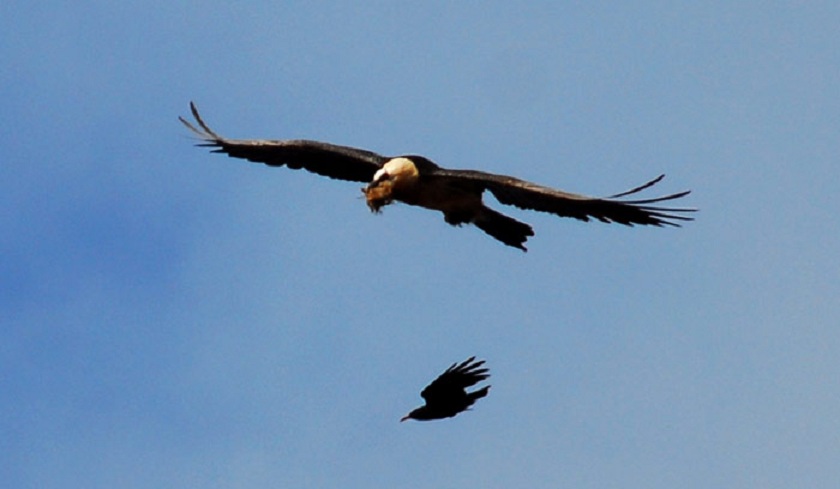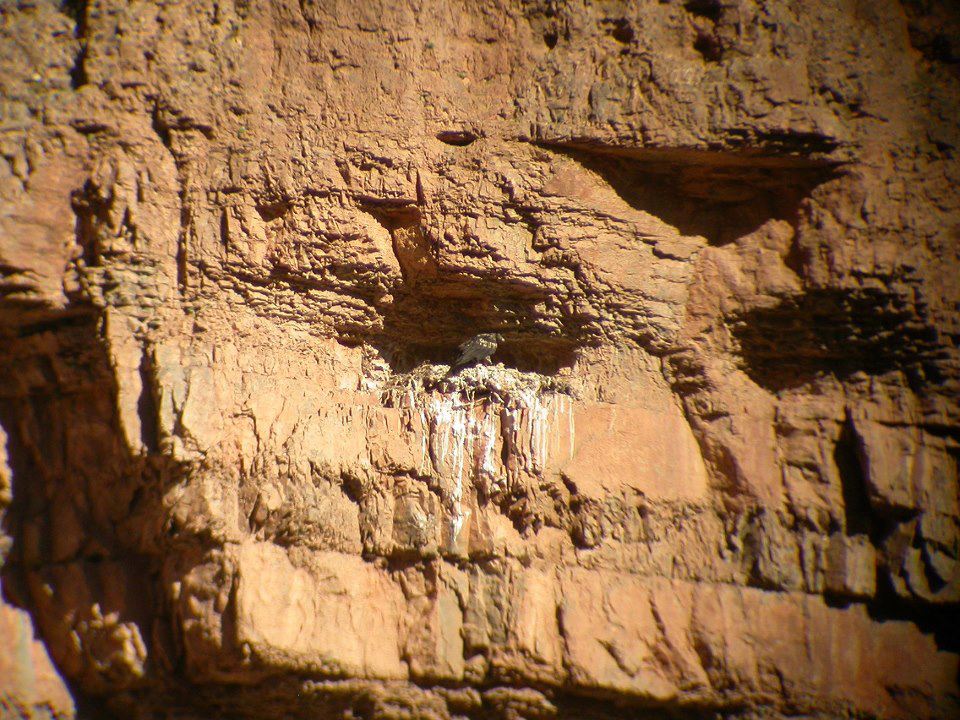The Bearded Vulture (Gypaetus barbatus) – or Lammergeier as some prefer to call it – is extremely rare in Morocco. It is considered Critically Endangered due mainly to the very small population size, restricted range and the ongoing threats from poisoning and disturbance from different sources (Thévenot et al. 2003, Cuzin et al. 2009 – see the ABSTRACT under photo 2).
Below, we summarised all known records of the species in Morocco (see the updates below for new information):
– In the 1990s, there were only 20 records: 15 in the High Atlas and 5 in the Anti-Atlas (Thévenot et al. 2003).
– In the 21st century, first records were obtained by Godino et al. (2003, 2004, 2006): at least 5 Bearded Vultures consisting of 2 adults and 3 juvenile/immature birds in the Western High Atlas, and 4 adults and 1 juvenile in the Central High Atlas.
– A juvenile observed by Cherkaoui et al. (2006) south of Jbel Ayachi in the Eastern High Atlas in December 2005.
– In spring 2007, a group of ornithologists from Andalusia and the Canary Islands localised an occupied nest of Bearded Vulture in Central High Atlas (photo 2).
– The Bearded Vulture was seen 10 times between 2007 and 2009 in the highest altitude (3000-4167 m.a.s.l.) of Toubkal National Park in the Western High Atlas (Cuzin 2010).
– In April 2009, an adult carrying wool was photographed with another bird at Oukaïmeden by Todor Todorov and Rachid El Khamlichi (see photo 1 below and a video here, other photos can be seen in Todor’s blog).
– A sub-adult seen near Oukaimeden on 7 December 2009 by Brian Stone (photo and video here).
– In November 2011, a 4-year old immature in pursuit of a Golden Eagle in an attempt to rob it of its prey was located in the High Atlas by Sierra-trek and Iberus Medioambiente after ten days of exploration.
The observations at Oukaïmeden become more or less regular recently probably because of the installation (?) of a pair nearby or because the site is frequently visited by birders.
Update 1: A first-year juvenile photographed in the High Atlas Mountains on 11 October 2013 by Juliette Boyer. This is probably the fist-ever photograph of a fledged juvenile in Morocco which shows that the adults are breeding and raising young (see photo 3 below).
Update 2: A third year immature Bearded Vulture was photographed by Ali Irizi near Jbel Toubkal, Western High Atlas, on 7 March 2015 (best photos for the species in Morocco so far!).
Update 3: A workshop to develop an “Action Plan for the Conservation of the Bearded Vulture (Gypaetus barbatus) in Morocco” was organised by the direction of the Toubkal National Park (HCEFLCD) at Imlil, High Atlas, on 21 and 22 October 2015. Participants included researchers from the Scientific Institute of Rabat (Mohammed V University) and GREPOM (BirdLife Morocco).
Update 4: A 2nd/3rd year Bearded Vulture observed at Jbel Toubkal on 22 July 2016 by Ahmed Raha and mountain guide Houssin (see last photo). Here is what Ahmed said about this encounter:”… the most spectacular was the huge raptor that appeared when we were at 4000 meters, I was not able to identify it, but Houssin told me that the area had three Bearded Vultures, some Golden Eagles and Bonelli’s Eagles”. Thanks Diego Jeréz for the information!
Updates 5: An adult bird observed at Tizi n’Tichka, High Atlas by Dutch birder Mats van Kasteren on 11 August 2017. Thanks Mats for the email!
Also, Idriss Omari from the local Forestry Administration (HCEFLCD) working on the Toubkal National Park observed a Bearded Vulture at the same park, probably in summer 2018 (see the undated video at ecologie.ma).
Update 6: On 12 July 2018, a pair with a newly fledged juvenile were observed at Jbel M’Goun, Central High Atlas, by Ismail Allaoui. See: Allaoui, I. & Cherkaoui, S. I. (2018). New breeding record of Lammergeier (Gypaetus barbatus barbatus) in Morocco and proposals for its conservation. Go-South Bull. 15: 137-140.


Fabrice Cuzin et al. summarised the known knowledge (up until 2009) about the Lammergeier in Morocco during the “2nd International Congress on the Bearded Vulture” organised at Jaen (Spain) in September 2009. The presentation entitled “Bearded Vulture in Morocco. Past, present, future?”
Citation:
Cuzin, F., Thévenot, M. & Mokhtari, S. (2009). Bearded vulture in Morocco: past, present, future? Presented at ‘II International Congress on the Bearded Vulture (Gypaetus barbatus) in Europe: new challenges for its conservation‘, 15th to 19th September 2009, Jaen.
Abstract:
455 data concerning Bearded Vulture in Morocco were compiled in a database. These data originated both from the bibliography and observations, partly produced by a network of observers, collected between 1905 and 2009. They show an important regression of this species, which disappeared progressively from the majority of Moroccan mountains (Rif, Middle Atlas, Central Plateau, Saharan Atlas, Anti Atlas and a large part of High Atlas). It is currently surviving only in Western and Central High Atlas, in two disjunctive areas. Bearded vulture’s population is estimated between 4 and 10 reproductive units. Despite legal protection, the species is considered Critically Endangered in the country, due to the small size of the population, currently decreasing as well as the ongoing threats it’s facing. The main threats range from poisoning meant to kill dogs and jackals, illegal shooting, general disturbance by shepherds and local one caused by rock climbers, lack of awareness, new overhead cables (mainly electric power lines) and., in the near future, local habitat loss and deterioration, due to the planned extension of Oukaimeden ski‐resort. There is no threat concerning the lack of food, as cattle raising is still an important activity. Older shepherds tend to know well the behaviour of this species, however younger ones often think it is a small cattle’s predator, like the Golden Eagle. The behaviour of the species is better known in Central High Atlas than in Western High Atlas. Beside data collection, various local actions of protection were already realized through Spanish Cooperation, GEF Project, Fundacion Gypaetus, Fundacion Global Nature: sensitization of mountain communities, that proved to be more effective among people living from tourism, trying to set a supplementary feeding station, realization of a leaflet and a billboard. Funding of a supplementary feeding station in Toubkal National Park coupled with sensitization activities are already granted y GTZ. Further actions that should be realized include an increasing effort in detecting and monitoring population in the whole High Atlas, sensitization of local communities and guides, training of the most involved individuals, setting a few supplementary feeding stations, and reducing threats. The elaboration of a management plan and the coordination of the different actors.

References:
- Cherkaoui, I., Essabani, A. & Rguibi Idrissi, H. 2006. Observation d’un Gypaète barbu juvénile Gypaetus barbatus dans le massif du Jbel Ayachi (Haut-Atlas Oriental, Maroc). Go-South Bull. 3: 4–5.
- Cuzin, F. 2010. L’avifaune de très haute altitude du Parc National du Toubkal (Haut Atlas, Maroc). Bull. Inst. Sci., Rabat, section Sciences de la Vie 32: 25-32.
- Cuzin, F., Thévenot, M. & Mokhtari, S. 2009. Bearded vulture in Morocco: past, present, future? Presented at ‘II International Congress on the Bearded Vulture (Gypaetus barbatus) in Europe: new challenges for its conservation‘, 15th to 19th September 2009, Jaen.
- Godino, A., Paz, J.L. & Simón, M.Á. 2003. Naturalistas españoles localizan en Marruecos cinco Quebrantahuesos. Quercus 205: 45-47.
- Godino, A., Paz, J.L. & Simón, M.Á. 2004. Localisan mas Quebrantahuesos adultos y jovenes en el Atlas. Quercus 217: 12-13.
- Godino, A, Paz, J.L., Mouati, N. & Simón, M.Á. 2006. Three years of Bearded Vultures’ surveys in Morocco. In: Frey H, Schaden G, Bijleveld van Lexmond M (eds), Bearded vulture annual report 2005. Foundation for the Conservation of the Bearded Vulture, Wassenaar. pp 98–102.
- Thévenot, M., Vernon, R. & Bergier, P. 2003. The Birds of Morocco. BOU Checklist No. 20. British Ornithologists’ Union, Tring.

While hiking in the Massif M’goun Wednesday, May 1, 2019, I spotted what I was told is one of two Gypaète Barbus in the area. I was able to capture a cell phone picture of the Bearded Vulture, but not until it was a distance away.